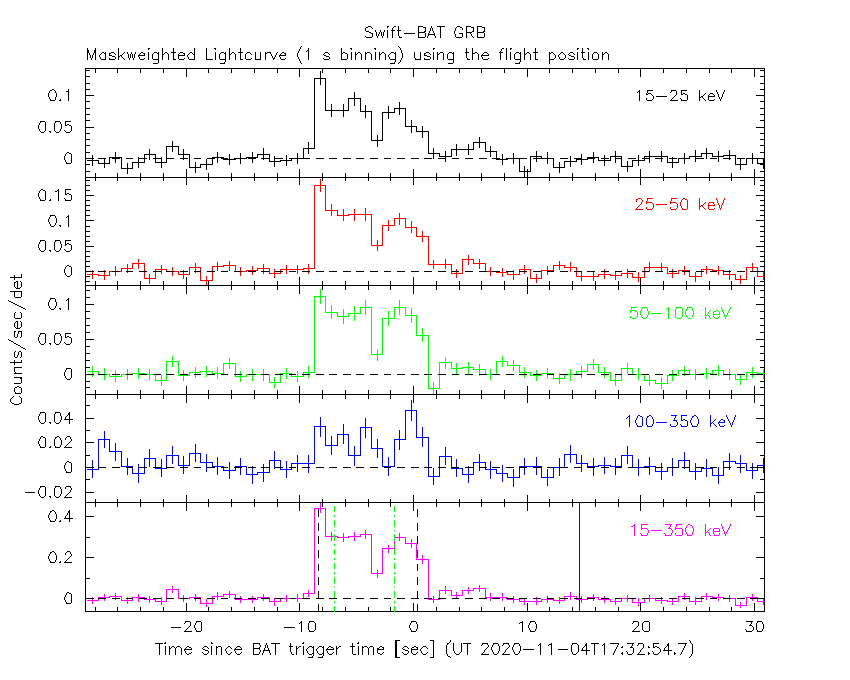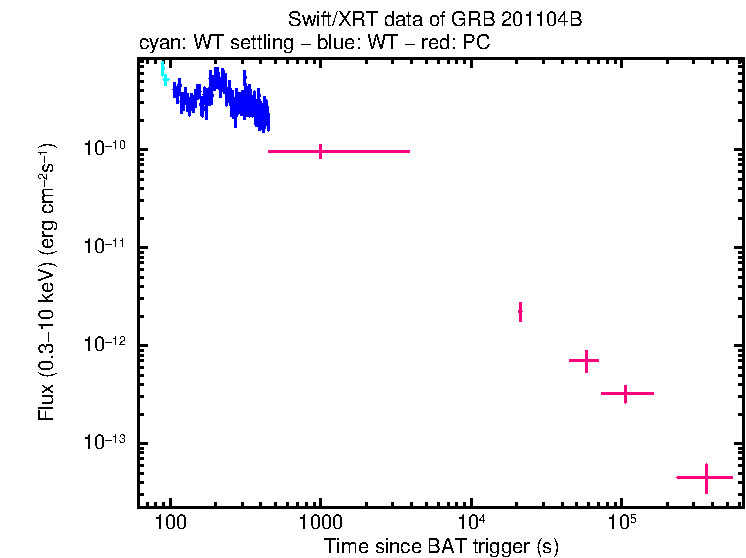
B. Sbarufatti (PSU), J.A. Kennea (PSU) and F.E. Marshall (NASA/GSFC) for the Swift team
At 17:33:46 UT, the Swift Burst Alert Telescope (BAT) triggered and located GRB 201104B (trigger=1004168) (Sbarufatti et al. GCN Circ. 28825). Swift slewed immediately to the burst. Table 1 contains the best reported positions from Swift, and the latest XRT position can be viewed at http://www.swift.ac.uk/xrt_positions.
Marshall et al. (GCN Circ. 28827) reported the detection with UVOT of an optical afterglow. Vielfaure et al. (GCN Circ. 28840) determined a redshift of 1.954 from VLT. Table 2 is a summary of GCN Circulars about this GRB from observatories other than Swift.
Standard analysis products for this burst are available at https://gcn.gsfc.nasa.gov/swift_gnd_ana.html.
As reported by Lien et al. (GCN Circ. 28839),
the BAT ground-calculated position is RA, Dec = 5.215, 7.834 deg which is RA(J2000) = 0
The mask-weighted light curve (Figure 1) shows several overlapping pulses that start at ~T-9 s and end at ~T+1 s.
The main peak occurs at ~T-8 s.
The time-averaged spectrum from T-8.86 to T+0.88 s is best fit by a simple power-law model.
The power law index of the time-averaged spectrum is 1.47 ± 0.07.
The fluence in the 15-150 keV band is 1.8 ± 0.1 x 1
The results of the batgrbproduct analysis are available at https://gcn.gsfc.nasa.gov/notices_s/1004168/BA/.
Analysis of the initial XRT data was reported by Kennea et al. (GCN Circ. 28850). We have analysed 4.9 ks of XRT data for GRB 201104B, from 105 s to 131.7 ks after the BAT trigger. The data comprise 347 s in Windowed Timing (WT) mode with the remainder in Photon Counting (PC) mode.
The light curve (Figure 2) can be modelled with an initial power-law decay with an index of α=0.11 (+0.11, -0.12), followed by a break at T+338 s to an α of 1.21 (+0.05, -0.04).
A spectrum formed from the WT mode data can be fitted with an absorbed
power-law with a photon spectral index of 1.80 ± 0.07. The
best-fitting absorption column is 1.12 (+0.30, -0.28) x 1
Analysis of the UVOT data was reported by Marshall et al. (GCN Circ. 28827).
Table 3 gives preliminary
magnitudes using the UVOT photometric system
(Breeveld et al. 2011, AIP Conf. Proc., 1358, 373).
No correction has been made for the expected extinction in the Milky Way
corresponding to a reddening of
The Swift/UVOT began settled observations of the field of GRB 201104B 56 s after the BAT trigger
(Oates and Sbarufatti GCN Circ. 28851).
A source consistent with the XRT position and UVOT position (Marshall et al. GCN Circ. 28827) is detected in the initial UVOT exposures.
Table 3 gives preliminary
magnitudes using the UVOT photometric system
(Breeveld et al. 2011, AIP Conf. Proc., 1358, 373).
No correction has been made for the expected extinction in the Milky Way
corresponding to a reddening of

Figure 1. The BAT
mask-weighted light curve in the four individual and total
energy bands. The units are counts

Figure 2. The XRT light curve.
Any data from a crosshatched region are not included in the fit.
| RA (J2000) | Dec (J2000) | Error | Note | Reference |
|---|---|---|---|---|
| 0 |
+07°50'29.4" | 0.43" | UVOT-refined | Marshall et al. GCN Circ. 28827 |
| 0 |
+07°50'30.7" | 2.3" | XRT-final | UKSSDC |
| 0 |
+07°50'30.7" | 2.3" | XRT-refined | Kennea et al. GCN Circ. 28850 |
| 0 |
+07°50'03.6" | 1.0' | BAT-refined | Lien et al. GCN Circ. 28839 |
| Band | Authors | GCN Circ. | Subject | Observatory | Notes |
|---|---|---|---|---|---|
| Optical | Lipunov et al. | 28826 | MASTER optical observation | MASTER | |
| Optical | Vielfaure et al. | 28840 | VLT/X-shooter redshift | VLT | redshift |
| Optical | Belkin et al. | 28852 | TSHAO optical observation | Zeiss-1000 | detection |
| Optical | Belkin et al. | 28856 | Kitab optical observations | ||
| Optical | Gupta et al. | 28860 | 1.3m DFOT optical observations | Devasthal Opt.Tel. | detection |
| Optical | Hosokawa et al. | 28870 | MITSuME Akeno optical observation | MITSuME Akeno | marginal detection |
| Optical | Belkin et al. | 28871 | continued TSHAO optical observation | Zeiss-1000 | detection |
| Optical | Belkin et al. | 29198 | Maidanak and CrAO optical observations | CrAO | detection |
| Filter | Exp(s) | Mag | ||
|---|---|---|---|---|
| white | 56 | 206 | 147 | 18.63 ± 0.06 |
| u | 268 | 459 | 188 | 19.45 ± 0.23 |
Table 3. UVOT observations reported by Marshall et al. (GCN Circ. 28827). The start and stop times of the exposures are given in seconds since the BAT trigger. The preliminary detections and 3-σ upper limits are given. No correction has been made for extinction in the Milky Way.
December 30, 2020